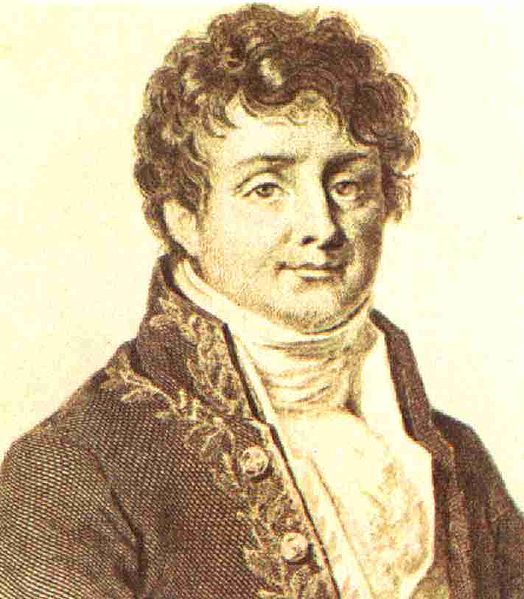<Back to Index>
- Mathematician Jean Baptiste Joseph Fourier, 1768
- Architect Albert Kahn, 1869
- President of Mexico Benito Pablo Juarez Garcia, 1806

Jean Baptiste Joseph Fourier (21 March 1768 – 16 May 1830) was a French mathematician and physicist best known for initiating the investigation of Fourier series and their application to problems of heat transfer. The Fourier transform and Fourier's Law are also named in his honour. Fourier is also generally credited with the discovery of the greenhouse effect.
Fourier was born at Auxerre (now in the Yonne département of France), the son of a tailor. He was orphaned at age ten. Fourier was recommended to the Bishop of Auxerre, and through this introduction, he was educated by the Benvenistes of the Convent of St. Mark. The commissions in the scientific corps of the army were reserved for those of good birth, and being thus ineligible, he accepted a military lectureship on mathematics. He took a prominent part in his own district in promoting the French Revolution, and was rewarded by an appointment in 1795 in the École Normale Supérieure, and subsequently by a chair at the École Polytechnique.
Fourier went with Napoleon Bonaparte on his Egyptian expedition in 1798, and was made governor of Lower Egypt and secretary of the Institut d'Égypte. Cut off from France by the English fleet, he organized the workshops on which the French army had to rely for their munitions of war. He also contributed several mathematical papers to the Egyptian Institute (also called the Cairo Institute) which Napoleon founded at Cairo, with a view of weakening English influence in the East. After the British victories and the capitulation of the French under General Menou in 1801, Fourier returned to France, and was made prefect of Isère, and it was while there that he made his experiments on the propagation of heat.
Fourier moved to England in 1816. Later he returned to France, and in 1822 succeeded Jean Baptiste Joseph Delambre as Permanent Secretary of the French Academy of Sciences. In 1830, he was elected a foreign member of the Royal Swedish Academy of Sciences.
In 1822 he published his Théorie analytique de la chaleur, in which he bases his reasoning on Newton's law of cooling, namely, that the flow of heat between two adjacent molecules is proportional to the extremely small difference of their temperatures. In this work he claims that any function of a variable, whether continuous or discontinuous, can be expanded in a series of sines of multiples of the variable. Though this result is not correct, Fourier's observation that some discontinuous functions are the sum of infinite series was a breakthrough. The question of determining when a Fourier series converges has been fundamental for centuries. Joseph Louis Lagrange had given particular cases of this (false) theorem, and had implied that the method was general, but he had not pursued the subject. Johann Dirichlet was the first to give a satisfactory demonstration of it with some restrictive conditions. A more subtle, but equally fundamental, contribution is the concept of dimensional homogeneity in equations; i.e. an equation can only be formally correct if the dimensions match on either side of the equality. Fourier also developed dimensional analysis, the method of representing physical units, such as velocity and acceleration, by their fundamental dimensions of mass, time, and length, to obtain relations between them.
Fourier left an unfinished work on determinate equations which was edited by Claude-Louis Navier and
published in 1831. This work contains much original matter — in
particular, there is a demonstration of Fourier's theorem on the
position of the roots of an algebraic equation. Joseph Louis Lagrange had
shown how the roots of an algebraic equation might be separated by
means of another equation whose roots were the squares of the
differences of the roots of the original equation. François Budan,
in 1807 and 1811, had enunciated the theorem generally known by the
name of Fourier, but the demonstration was not altogether satisfactory.
Fourier's proof is the same as that usually given in textbooks on the
theory of equations. The final solution of the problem was given in
1829 by Jacques Charles François Sturm. Fourier
believed that keeping the body wrapped up in blankets was beneficial to
the health. He died in 1830 when he tripped and fell down the stairs at
his home. Fourier was buried in the Pere Lachaise Cemetery
in Paris, a tomb decorated with an Egyptian motif to reflect his
position as secretary of the Cairo Institute, and his collation of the
landmark Description de l'Égypte Fourier
is also credited with the discovery in 1824 that gases in the
atmosphere might increase the surface temperature of the Earth. This was the effect that would later be called the greenhouse effect. He described the phenomenon in 1824 and then again in a very similar paper in 1827 whereby an atmosphere serves to warm a planet. This
established the concept of planetary energy balance — that planets
obtain energy from a number of sources that cause temperature increase.
Planets also lose energy by infrared radiation (that Fourier called "chaleur obscure" or
"dark heat") with the rate increasing with temperature. A balance is
reached between heat gain and heat loss; the atmosphere shifts the
balance toward the higher temperatures by slowing the heat loss.